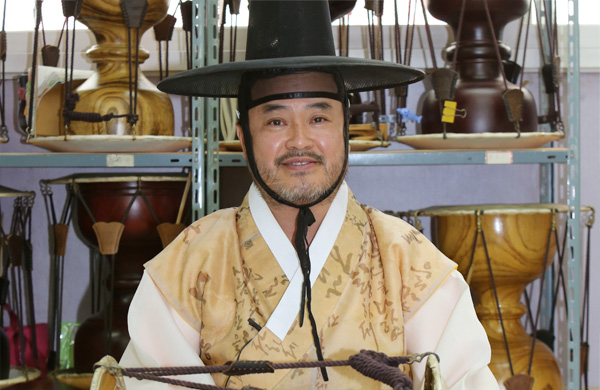Cultural heritage in Goyang
five-thousand years history
Current story of Goyang
In Beautiful Goyang-si, there are people who are designated as cultural property for their artistic value
Singing ‘Kwonsoo Kim’ singing for the sorrow of citizens
( (Intangible cultural asset in Gyeonggi-do 31-1 | Date of designation : 2016.11. 08 )

Japga (雜歌) is the folk song that was sung by working classes in the late Joseon Dynasty. It has long lyrics and was sung by professional singers to earn money in the place with many people. ‘Huimorijabga’is the song represented by listing a long story in fast beat as shown in the name. Based on the one handed down in Seoul and Gyeonggi-do, it is called as ‘Gyeonggi sound Huimorijabga’There are [Gombotaryong], [Saengmaejaba], [Manhakcheonbong], [Rainy days on June and July], [Pour the shot], 「Byungjungtaryeong (兵丁打令)」, 「Sungumtaryeong(巡檢打令)」, 「Bidantaryeong」, and 「Maenggongitaryeong」.
It was designated as intangible cultural asset 31-1 in Gyeonggi-do as of November 8, 2016.
What is Huimorijabgi?
There are many Japgas for those who participate in Gyeonggi singing. It is called as long Japga that there are 12 kinds of Japga. In addition, there is a Huimorijapga that has been designated as cultural asset now. Among Huimorijapgas, there are 11 songs. These 11 songs include ‘Bawitaryeong,’ ‘Bidantaryeong,’ and all others that I just showed you. It is called as Huimorijapga as they sing as if it goes around. Characteristics of them include a specific form along with much of humor and satire.
How Guimorijabgi is related to Goyang-si?
The area outside the four doors in Seoul is Goyang-gun, right? In fact, those singers such as Changbae Lee were all from Yonggang-myeon, Goyang-gun, or Yonggang-myeon, Gongdeok-ri. Those singers in early generations all sang there according to the records. Therefore, it is an established theory that songs were originated from Goyang, now Goyang-si.
What is the difference between general Gyeonggi folk song and Huimorijabgi?
Gyeonggi folk songs have such fun and joy, right?
If I imitate a bit, this is the gist of Gyeonggi folk songs. In fact, this is ‘Changbutaryeong.’
Actually.. (song) Loyal subject is Manjojeong (滿朝廷). Devoted daughter is Gagajae (家家在), and it is about 和兄弟樂妻子. As we now have dance related to this line, these are characteristics of Gyeonggi folk songs as they are bright and fast-paced. Among them, Junganghoi and Gyeonggi folk songs are the same. However, there are no cultural assets that have been designated as folk songs. As I told you before, long japgas are 12 japgas and hence designated as cultural assets. Then, Huimorijapga is designated followed by Seongoritaryeong. However, they are bright and fast-paced in terms of the context and sound. However, Huimorijapga does not have consistent beat. For example, Gyeonggi folk songs are classified into Gutgeori, Jajinomori, or Semachi. I do not know whether they are their characteristics, but Gyeonggi folk songs are classified.

Do you perform activities related to Goyang-si other than Huimorijabgi?
Yes, I am singing with the tale in Goyang-si.
The member, Dr. Dongil Chung, in Goyang-si would know better, but there are many tales in Goyang-si. There are stories about a beautiful woman with last name Han in Goguryo from Gobongsan Mountain or white rocks in White Rock Village, grandmother of meals, or Songgang Jungchul, or the beloved concubine, Kanga, of Jungchul in front of them, etc. I have created many of the works based on them as a theme. Performance I have been participating in so far was about the beautiful woman with last name Han during the king Anjang in Goguryo near Gobongsan Mountain.
Then, I used my personal expenses creating the story of officer Kwonyul in Hangju Fortress and performed them for two times. Since I have performed in Goyang-si for a long time except for Gyeonggi folk songs, I created songs based on tales in the area and performed them for residents.
How long have you been singing?
Roughly, it is about 34-5 years.
Have you only performed Gyeonggi singing?
Yes, I have.
How are you handing down Huimorijabgi?
After I became the cultural asset, I have been handing down for 25 years. I have performed here and also in other places. However, I have been handing down the singing skills for about 25 years only in Goyang-si.
After I became the cultural asset, I always recruited trainees to hand down my singings skills, and they needed to complete the courses to be qualified. In Gyeonggi-do, I am teaching 20 to 30 students every Monday and Wednesday. I am teaching Huimorijapga during day times and night times. Therefore, I have been teaching them for 3 years. With such courses, they are qualified to be handed down with singing skills. Therefore, we are now in a process of handing down singing skills to them. We are conducting a session twice a week (every week).
On November 08, 2016, master singer Kwonsu Kim was designated as the 31-1th intabgible cultural property in Gyeonggido.Master singer Kim beautifully comforts hearts of Goyang-si